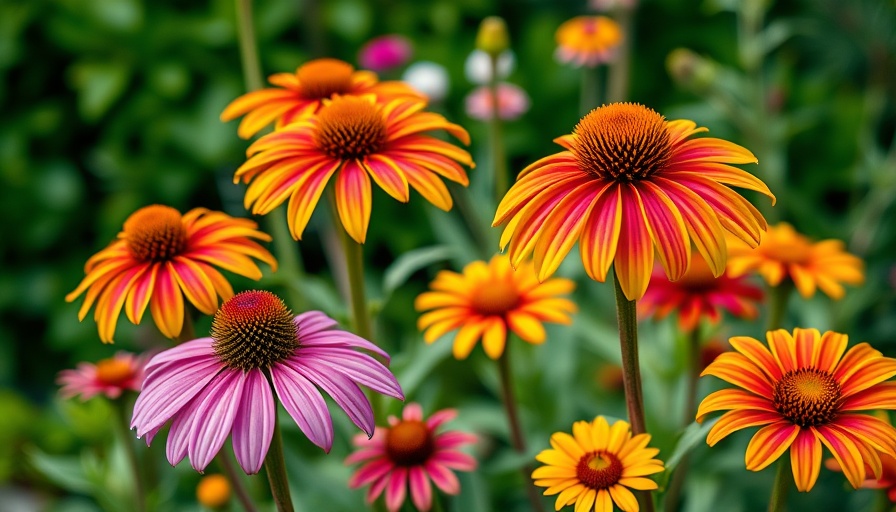
Enhancing Your Garden with Companion Plants for Coneflowers
Coneflowers, known for their vibrant colors and resilience, are a favorite in many gardens. With various cultivars like the pink, purple, and white Echinacea species blooming from early summer to fall, they're not only beautiful but also low-maintenance. They flourish in USDA Hardiness Zones 5 to 9, bringing a splash of color to any outdoor space. But did you know that pairing them with the right companions can make your garden even more attractive and productive?
Why Companion Planting Matters
Companion planting is more than aesthetics; it benefits plants' health and yields. When planted together, certain species can protect one another from pests, improve growth, and even enhance flavor. Coneflowers thrive in full sun to partial shade and prefer slightly acidic, well-draining sandy loam, making them suitable partners for a variety of other plants.
A Dynamic Duo: Anise Hyssop and Coneflowers
First on our list is anise hyssop (Agastache foeniculum), a perennial beloved for its gorgeous blue and lavender spikes that bloom from midsummer until fall. Not only does it attract pollinators like bees and butterflies, but it also self-sows, creating a natural, thriving landscape. Its aromatic leaves serve culinary uses and traditional medicinal purposes, which enhances interactivity in the garden by inviting pollinators and offering edible delights.
The Allure of Asters
Asters are another fantastic companion, presenting a cascade of small flowers in hues of blue, purple, and white that bloom from late summer to fall. Their adaptability across various species allows them to fit into numerous garden designs, whether in wildflower plantings or more structured settings. These native perennials reach heights of up to 72 inches, providing a striking contrast with the more robust coneflower.
Diverse Yet Complementary: Other Great Coneflower Companions
Beyond anise hyssop and asters, gardeners have a vast selection for companions that work harmoniously with coneflowers. Here are some notable mentions:
- Bee Balm - A fragrant addition that attracts hummingbirds and bees, contributing to the ecosystem's health.
- Black-Eyed Susans - Their bright yellow petals offer a stunning visual and thrive in similar conditions.
- Marigolds - Known for being pest-repellent, they can help keep harmful invaders at bay.
- Cosmos - These delicate flowers not only enhance beauty but can also improve garden biodiversity.
- Yarrow - Robust and drought-resistant, it complements coneflowers and is often used in herbal remedies.
The Growing Impact of DIY Gardening
As urban and suburban homeowners increasingly embrace DIY gardening, understanding which plants pair well together has become essential for crafting flourishing gardens. The rise of sustainable living movements reflects a growing desire to connect with nature, grow food, and create green spaces in urban settings. Incorporating versatile plants like coneflowers and their companions not only beautifies surroundings but also contributes to a more sustainable lifestyle.
Practical Tips for Planting Coneflower Companions
When planting your coneflower companions, consider these essential tips for ensuring success:
- Select plants that share similar sunlight and soil requirements.
- Spacing is vital; give each plant enough room to grow and mature without overcrowding.
- Regularly check for signs of pests, and encourage biodiversity to attract natural predators.
- Experiment with different pairings to find out which combinations work best in your specific garden environment.
Stepping Into the Future of Gardening
As gardens evolve, so too do gardening practices. The connections between plants lead to a richer gardening experience, one that offers not only beauty but ecological benefits as well. With an increasing number of homeowners prioritizing sustainability, the powerful duo of coneflowers and their companions helps pave the way for climate-friendly gardening approaches.
In gardening, every choice counts, and the path to a thriving ecosystem starts by understanding the importance of plant relationships. By embracing these practices, you can cultivate not only plants but also connections within your community.
Explore the art of companion planting to unlock the secrets of a flourishing garden!
 Add Row
Add Row  Add
Add 




 Add Row
Add Row  Add
Add 

Write A Comment